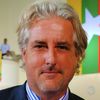Back in 1970, there were many inventive, vibrant ideas about how to bring America's attention to what was happening to our environment--pesticides in the water, burning rivers, and air dense with smog. Earth Day was one of these ideas. It was conceived as a way not only to raise awareness about the destruction of our natural world, but also to celebrate the Earth. It wasn't just a protest--it was a joyous event too.
Patricia and I participated in this nascent celebration in Greenwich Village with a small group of very committed individuals including Richard Ottinger, a New York Congressman, who had spoken at our founding conference a month before.
NRDC has been open all of four months when the first Earth Day occurred. We had launched it on January 1, 1970 because a small group of us--including respected conservationists who had blocked a power plant on Storm King Mountain on the Hudson River, a handful of determined students from Yale Law School, and myself had decided it was time to stop the environmental assaults that were spreading across America's cities and landscapes.
You have to remember those were different times.
January 1969 brought the massive Santa Barbara oil spill, just off the coast of California. In June, an oil and garbage slick on the Cuyahoga River in Ohio had caught fire. I remember traveling to Gary, Indiana, seeing the city's fire-spewing smokestacks, and thinking it literally looked like Hell.
Back in New York, I ate my lunch outside everyday in Battery Park, and I would see raw sewage bobbing in the Hudson. If Patricia and I put our young children to sleep by an open window in our apartment, they would wake with soot on their foreheads. Patricia read that a New Yorker breathed as much poison each day as someone who smoked a pack of cigarettes. She said, "It's one thing for me to choose to breathe such air--but what about our children?"
These were the concerns that gave birth to Earth Day and to organizations like NRDC and Friends of the Earth.
Granted, we were making it up as we went along. NRDC was the first public interest law firm dedicated to the environment, and there was no roadmap for where we would go. And in those early days, we barely had office space or payroll. We were living dollar to dollar, and some of the first staff members had to stay on couches at our apartment.
One month before Earth Day, NRDC held our founding conference in Princeton. Thanks to support from the Ford Foundation and the guidance of Storm King champions David Sive and Beatrice and Stephen Duggan, we put together a stellar lineup of speakers. We had legendary David Brower; New York Congressman Richard Ottinger; Princeton biologist Dr. Robert Faulk; John Oakes, editor of the New York Times editorial page; and theater critic Brooks Atkinson.
The group from Yale came as well, including Gus Speth, Dick Ayres, John Bryson, and Ed Strohbehn. So did a third-year student at Columbia Law School named David Hawkins. Dave came to the conference to lobby John Oakes to have the New York Times demand that Fifth Avenue be closed for the first Earth Day. But then Dave got another idea: he asked Dick Ayres how he could get a job with NRDC.
"Are you kidding?" Dick responded. "We don't even have money for our own salaries yet." David did eventually get that job, and he is still with us today as head of our climate center.
The conference was a great success. People grasped what needed to be done to protect the Earth, and we felt energized to get started.
That same spirit was catching on across America. A month later, Earth Day celebrations erupted in cities and campuses. Over the course of the next several months, Congress introduced more than 1,000 new bills aimed at protecting the environment. The Environmental Protection Agency opened its doors, and the Clean Water Act and the Clean Air Act become law. It was the start of so much we cared about, so much we built our work upon.
Now NRDC is 40 years old. We have more than 350 staff members and six offices, including one in Beijing. I am extremely proud of all that we have accomplished.
Earth Day has also matured. I have come to realize that every generation has to learn to fight for themselves. Everything has to be reborn, and Earth Day helps do that. It draws new generations in and keeps alive the spirit of environmental protection.
This is critical, because memory is short. Back when Newt Gingrich's 104th Congress came in, they had already forgotten how horribly polluted the nation had been just 30 years before. They said we don't need environmental laws; the companies will take care of themselves. That is total baloney, but we had to fight their short-term memory.
That is why we keep rebuilding the environmental movement, rebuilding the leadership--so that the value of safeguarding the Earth is carried on. That is why we have so many young people at NRDC. Each generation has new energy and new skills to bring to bear.
This year, I will spend Earth Day in the Catskill Mountains in Upstate New York, where Patricia and I live. We will be putting the finishing touches to our book, A Force for Nature, a 40-year history of NRDC which Chronicle Books will publish in the fall. We love this region, and we work hard to protect its forests and streams.
I hope the coming Earth Day will inspire other people--and especially young people--to do the same for places they love too.
[This blog post originally appeared at NRDC Action Fund's The Markup]
